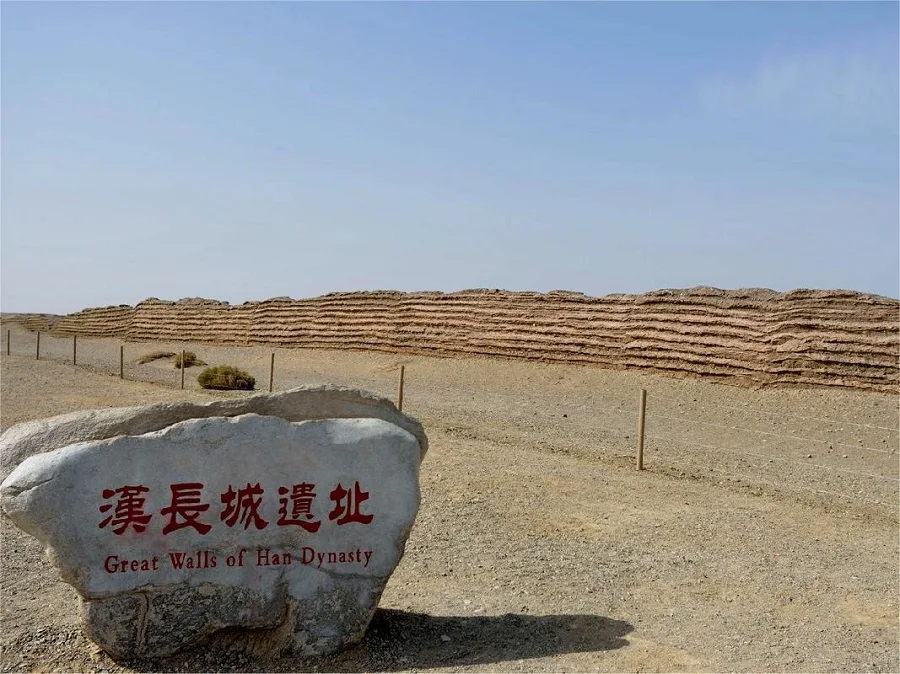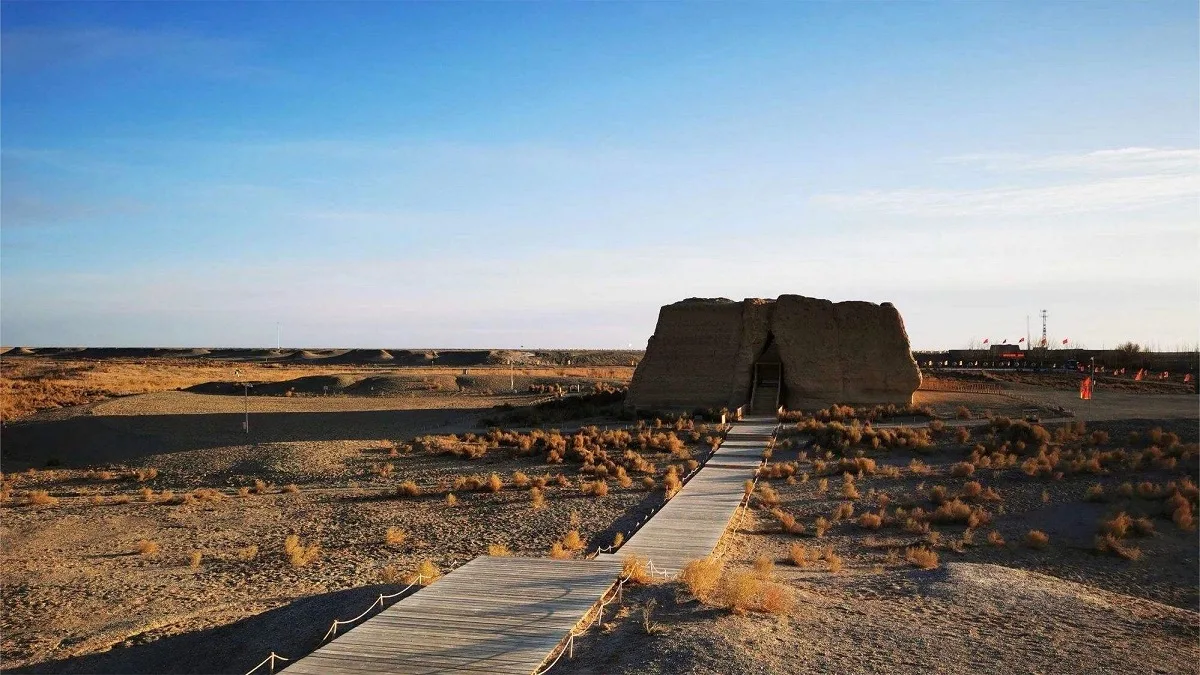Yumen Pass (Yumenguan, Jade Gate Pass, Yumenguan, 玉门关), also known as Xiaofangpan City, was constructed around 111 BC during the reign of Emperor Wu of the Han Dynasty. It served as a crucial gateway on the northern route of the Silk Road leading to the Western Regions.
Located in a desolate desert region, Yumen Pass sits amidst vast stretches of desert and gravel plains. To the north and south stand the Altun Mountains and Mazong Mountains, respectively, enclosing a flat corridor-style plain that extends towards the eastern part of Xinjiang Uygur Autonomous Region. Rivers flow through here, eventually draining into the Lop Nur Basin. Yumen Pass marks the junction between the great Gobi Desert and an alluvial plain.
The existing city wall of Yumen Pass is well-preserved and forms a square shape, constructed primarily with rammed earth. It stands 10 meters high, with a top width of 3 meters and a base width of 5 meters. The wall measures 24 meters east to west and 26.4 meters north to south, encompassing an area of 633 square meters. There are gates on the west and north walls. The pass includes remnants of 2 city sites, 20 beacon towers, and 18 sections of the Han Dynasty Great Wall, some of which are open to visitors such as the Xiaofangpan City Site, Dafangpan City Site, and the surrounding Han Great Wall sites at Dangugu Beacon.
Table of Contents
- Basic Information
- Location and Transportation
- Highlights of Yumen Pass
- Vlog about Yumen Pass
- History of Yumen Pass
- Other Attractions in West Dunhuang
Basic Information
| Estimated Length of Tour | 1 – 2 hours |
| Ticket Price | 20 RMB for Yumen Pass, Han Great Wall, and Hecang City Remants * These three attractions form a vast scenic area |
| Opening Hours | 7.00 – 19.00 |
| Telephone Number | 0086-0937-6951018 |
Location and Transportation
Yumen Pass is located on the Gobi Desert approximately 80 kilometers northwest of Dunhuang City in Gansu Province, China. To reach Yumen Pass from Dunhuang, one needs to travel about 90 kilometers by car. Currently, there is no direct public transportation available to Yumen Pass. It is recommended to either hire a private car or seek assistance from local travel agencies. The cost of hiring a car is approximately around 300 yuan.
Highlights of Yumen Pass
Han Great Wall

The Han Great Wall was a crucial component of the military defense system in the Hexi region during the Western Han Dynasty, serving as a microcosm of the entire northern defense project of the dynasty. Constructed to protect against nomadic invasions, especially from the Xiongnu, it spanned strategic points from Dunhuang to the western frontier.
In Dunhuang, remnants of the Han Great Wall extend from Jiandunzi to Mamitu along the main line. Additionally, there are branch lines such as from Yumen Pass to Yangguan, Yangguan to Danghekou, and Mamitu to Wanyoudun. Over two millennia, some sections of the Great Wall have succumbed to the ravages of time, wind, and sand, reduced to mere rubble. Nevertheless, much of the Great Wall has endured, preserving its historical significance.

Among the preserved sections, the stretch west of Yumen Pass near Danggu Tunnel stands out for its excellent condition. Here, the wall features a base width of 3 meters, a remaining height of 3 meters, and a top width of 1 meter, making it one of the most intact segments of the Han Great Wall in China.
Furthermore, the beacon tower sites of the Han Great Wall in Dunhuang are scattered across the western, northern, and eastern Gobi deserts. Stretching along the southern bank of the Shule River, they connect eastward from Huobi Dun and Dongjiandun to the Han Great Wall of Guazhou. Notably, the section northwest of Yumen Pass near Danggu Tunnel preserves a segment with a height of 2.95 meters, a base width of 3 meters, and a top width of 0.65 meters, spanning approximately 300 meters. The main line of the Great Wall features 85 beacon towers, with some of them still in relatively good condition, offering a glimpse into ancient Chinese military strategy and engineering prowess.
Hecang City Remnants

Hecang City, commonly known as Dafangpan City, was built during the Western Han Dynasty and is situated in the Gobi Desert about 60 kilometers northwest of Dunhuang, with Yumen Pass (Xiaofangpan City) approximately 20 kilometers to the west.
Located in a depression next to the ancient path of the Shule River, which runs east to west, Hecang City is positioned about 50 meters west of a large lake with mirror-like, azure waters. The lake’s shores are lined with reeds, red willows, and licorice, while to the east lies a deep and impenetrable marshland. The city itself was constructed on a raised earthen platform about 3 meters above the lake bed. Its name “Hecang” derives from its proximity to the Shule River.

Protected by high sand dunes to the north and south, Hecang City was well-hidden and not easily visible unless approached closely. The city was rectangular in shape, built with rammed earth walls that have since collapsed, leaving behind only remnants. Its dimensions were approximately 132 meters east-west and 17 meters north-south, with the tallest remaining ruins reaching 6.7 meters. Inside the city, towards the northern part, there was a warehouse measuring 17 meters wide and 132 meters long. The interior was divided by two north-south walls, creating three equal and parallel storage areas. Each area had its own entrance. Most of the walls have deteriorated, with only the northern wall relatively intact.
The walls were designed with triangular ventilation holes, three on top and five below, evenly spaced and alternating, likely serving as ventilation structures. Surrounding the city were two additional layers of walls on the east, west, and north sides. The outermost wall, though mostly in ruins, still shows traces of its original structure, with visible traces of earthen mounds at the corners. The second wall layer remains primarily evident on the northern side with remnants of earthen mounds.
Vlog about Yumen Pass
History of Yumen Pass
During the Spring and Autumn Period and Warring States Period (around 770-221 BC), the Yuezhi and Wusun tribes successively inhabited the area, engaging in nomadic pastoralism.
In 138 BC, during the Western Han Dynasty, Emperor Wu of Han dispatched Zhang Qian on the first official mission to the Western Regions. This mission aimed to forge alliances with the Yuezhi against the Xiongnu, marking the beginning of Han China’s strategic interests in the region. Subsequent military campaigns by General Huo Qubing in 121 BC further secured Han control in the Hexi Corridor, establishing Wuwei Commandery and Jiuquan Commandery. Zhang Qian’s second mission in 119 BC further expanded Han influence westward, reaching as far as Yumen Pass.
During Emperor Wu’s reign (140-87 BC), the Han Dynasty consolidated its presence in the region, fortifying key strategic points including Yumen Pass. The pass became a crucial defensive outpost and a pivotal checkpoint along the Silk Road, guarding the eastern entrance to the Hexi Corridor.
In the Eastern Han Dynasty (25-220 AD), generals such as Ban Chao undertook expeditions to the Western Regions, reinforcing Han control and cultural influence. Ban Chao’s tenure as the Protector General of the Western Regions from 73 AD to 102 AD was instrumental in maintaining stability and facilitating trade along the Silk Road.
During the Wei and Jin Dynasties (220-420 AD), Buddhist monk Zhu Falan’s journey from India to China marked the beginning of Buddhist influence in the region. Later, in the Northern Wei period (386-535 AD), the region saw further cultural exchanges and religious activities.
In the late 19th to early 20th centuries, British scholars like Aurel Stein conducted significant explorations and excavations in the Yumen Pass area, unearthing ancient artifacts and manuscripts that provided valuable insights into the history of the Silk Road.
In modern times, archaeological investigations by Chinese scholars in 1944 revealed numerous Han Dynasty bamboo slips (ancient documents) at Yumen Pass, shedding light on administrative practices and military operations during that period.
Today, Yumen Pass continues to attract visitors interested in its historical significance and the Silk Road’s legacy. Managed as a scenic area since August 2017, it stands as a testament to millennia of cultural exchange and strategic importance in China’s history.





